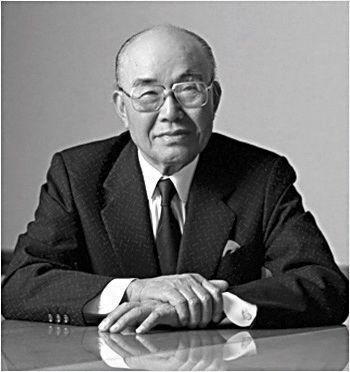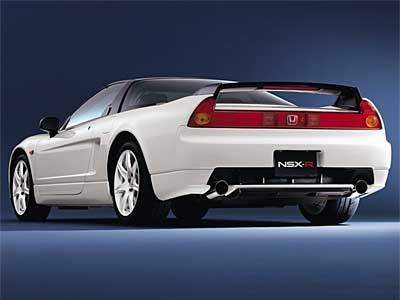 |
| Soichiro Honda (http://image.motortrend.com/f/27525139+w1500+ar1+st0/soichiro-honda.jpg ()) |
Matthew Nguyen Mrs. Young HSE2: Per. 2 May 15, 2012 Soichiro
Honda A
young boy stares at a dirt road, in front of his home, in a small village in
Japan. He stares in amazement as a Ford Model T drives by leaking oil. Then he walks to the puddle of oil and
sniffs and touches it. It was at that moment Soichiro Honda's obsession of
cars was born. Although Honda is no longer living today, his passion for
automobiles is still alive. "Honda Motor Co. sold 2.94 million cars in just
2011 alone (Boyle)." Honda had faced many hardships while trying to create his
company. Those hardships would eventually make him the person he is. "In World
War II his factory took a direct hit (Boyle), and while competing in a race he
crashed and sustained several injuries (Soichiro Honda Business Library)". "He
also had a hard time getting the Japanese government approval to start his
company". "Soichiro Honda was the first Japanese automaker to enter the
Automobile Hall of Fame. In 2009, Honda sold 1,150,784 cars in the United
States alone (Business library)". However, Honda faced many challenges before
he reached success. All the problems Honda faced made him persistent, open minded,
and innovative.
"Honda
delayed automobile production because the Japanese Government discouraged small
companies from competing with bigger companies, such as Nissan and Toyota.
Small companies such as Honda Motor Co. was to remain in their current position
on the market. Honda, however, took an unusually aggressive approach to stand
up to the Japanese Government, and by the early 1960's, his company would
finally see action. In 1962, a lightweight truck was introduced, and in the
following year a sports car made its début. Honda's first lightweight passenger
car was put on the market in 1967. One of Honda's greatest successes was the
introduction of the Honda Civic in 1972, which was to go on sale as a 1973
model, when the Civic model was launched. (Boyle)." Today the Honda Civic is still a popular
choice of cars among the working class all over the world. The Civic possessed
a compound vortex controlled combustion engine system or CVCC, which gained a
quick advantage over the competition by being the first to meet the 1975
emission standards created under the United States Clean Air Act (Boyle). Honda's own government was against him. Honda's Company was already the biggest
motorcycle manufacture in Japan, and the fact the Japanese Government told Honda
not to enter automobile production had a big impact on Honda's decision to
begin production of automobiles. Honda had realized going into the car industry
would be difficult. Finally, in August 1962, Honda Motor Company produced its
first automobile a lightweight truck (Boyle). Honda is my hero because he got the courage
to stand up to do what he dreamed of. Honda Motor Co. is responsible for
creating several innovative automotive break through such as the CVCC engine,
was able to comply with the United States Clean Air Act. The United States
Clean Air Act was troublesome for the domestic automobile companies. The
competition they would have to up their quality, get better gas mileage, and
pass new strict SMOG requirements. Something Honda had accomplished with the
Civic. Soichiro Honda is my hero because without Honda Motor Co., quality of
automobiles would be low. Unfortunately for Honda, his company ran into trouble,
as it was about to take off. "Honda's Company, prospered as The Japanese Military
demanded more and more of his company's products, including piston rings and
metal aircraft propellers, accelerated. In the final year of World War II, his
factory took a direct hit in a bombing raid and was damaged more due to an
earthquake. (Boyle)" Honda was successful during the years of the war. When bombs hit Honda's factory, he didn't let
that stop him. Honda was strong and got the courage again to rebuild another
factory and go into automobile productions. Honda also came up with a new idea. Why not
have a factory in a different country?
Soichiro
Honda was not only persistent, but he was also had an opened minded and did a
lot of things other automakers didn't think of before. Honda had dreamed of a
factory off his home turf, so he set out to build one. "A Maverick in the
Japanese industry, Honda was the first to accept the idea of manufacturing in
the United States when most Japanese thought it would be a mistake building a
factory in foreign soil. (Honda soichiro) " They thought they could not watch
the production line if it wasn't on their land. At the time Japanese carmakers thought
American cars were bad because of the workers. They thought the workers were
lazy and sad. Soichiro Honda proved them wrong when he opened his factory in
Ohio. He proved American workers can get the job done and do it well. Honda was
so opened minded; in fact, he let one of his most successful cars enter in the
United States. "The Honda civic in 1972, which would sale as a 1973
model, when the Civic model was launched. (Boyle) " The civic was the game
changer for Honda. The car was and still is popular in the United States
because it gets better Gas mileage than other cars, and it has better quality.
This didn't just help Honda make profit, but it also help the American car
companies build better cars with better gas mileage and quality, which American
cars now posses. Honda not only challenged himself to make quality cars, but he
also challenged his competitions.
 |
| Honda NSX Type R (http://www.ssip.net/upload/honda-nsx-r-back-3_70.jpg ()) |
"Honda created a lot of things for his
automobile at the time where revolutionary. When Honda felt his bicycle wasn't
quick enough to get around, he created a small motorcycle. Gas for cars was
expensive after the war, so Honda rode the train every day. He hated riding the
train, but riding his bicycle was too slow. So Honda came up with a
revolutionary idea. "He combined the
bicycle's structure and a small motor to create a mini low cost motorcycle. "This caught the interest of a local businessman
Takeo Fujisawa, who had a motorcycle factory. Honda and Fujisawa then teamed up
and founded the Honda Motor Company (soichiro). Honda continued to improve motorcycle engines
to make them more powerful and efficient while keep them at the same low price.
Honda was good at problem solving. That creation alone helped him eventually
become the largest motorcycle company in Japan. Honda was creative and often
found unique solutions to his problems. Honda wasn't just creative with motorcycle;
he was also good with cars. "Honda intended to compete in North America with
Germany's Volkswagen, in order to have his Civic have an extra
"Oomph", he had the Civic possess a compound vortex controlled
combustion engine system or CVCC, which had a big advantage over the
competition by being the first car to pass the 1975 emission standards set
forth by the United States Clean Air Act (Boyle)". For Honda this meant the Civic
was better than the Volkswagen, by having parts and doing things Volkswagen's
cars couldn't do. This meant the Civic was a clean car to drive because it does
not pass off as much poisonous gas to the air. All those made Honda become an
excellent automaker. "He became the first Japanese carmaker to enter the
Automobile Hall of Fame. (Soichiro) "
Honda
faced many roadblocks before he had reached success. He was bombed and lost his
factory (Boyle). His own government didn't want him to do what he dreamed of
(Boyle). Honda's hardships in his eyes were not roadblocks, but it made him and
his company stronger and brought him success. Soichiro Honda inspires me
because he showed me if you put your mind to something you can succeed. He
showed me, when you face difficulties; you have to push through them. In the
end when trying to reach success we all need heroes that can provide us with a
sense of direction. We all need someone who we can look up to for help or
direction. As Honda once said, "Success is 99% failure." Works Consulted Boyle, John H., and Boyle John H.
"Soichiro Honda." Great Lives From History: The Twentieth Century
(2008): 1. Biography Reference Center. Web. 9 May 2012. "Honda, Soichiro
(1906-1991)." Encyclopedia of World Biography. Detroit: Gale, 1998.
Gale Biography In Context. Web. 8 May 2012. Sakiya, Tetsuo. "World
Biography." Soichiro Honda Biography. The Gale Group Inc., 2004. Web. 9 May 2012. "Soichiro Honda."Bloomsbury
Business Library - Business Thinkers & Management Giants (2007): 17. Biography Reference Center.
Web. 8 May 2012.
Page created on 5/25/2012 12:00:00 AM
Last edited 5/25/2012 12:00:00 AM
